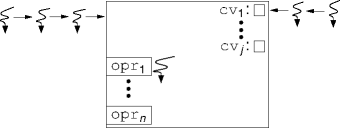Outline
- Recap
- Better primitives.
- Higher-level managers.
- Stones, bowls and semaphores.
- Operating systems assist.
- Still higher-level managers.
- ADTs, classes, and monitors.
Where are We?
- Tame uncoordinated, concurrent, shared access.
- Solve through concurrency, move to coordination.
- Concurrency tamed by mutual exclusion in critical sections.
- Via user-land code or interrupt disabling.
What’s Wrong?
- Peterson’s algorithm.
- A spin lock.
- Disconnected from the OS.
- Unwise scheduling decisions on both sides.
- Disabling interrupts.
- Touchy and inflexible.
- Monstrously difficult errors to find and fix.
- Better mutual exclusion primitives.
What’s Next?
Stones and Bowls
- Some rules for critical section cs:
- There’s a bowl at enter cs.
- A thread in cs must hold the stone.
- The thread at exit cs puts the stone in the bowl.
- A thread at enter cs wanting into cs must take the stone from
the bowl first.
- These rules provide mutual exclusion, progress, and starvation. And
independence.
Modern Stones and Bowls
- The modern version of the stone in a bowl is the
test-and-set instruction.
- The bowl is a boolean variable b.
- If b = true, the bowl holds the stone.
- If b = false, the bowl is empty.
-
test-and-set is a non-interruptable, non-privileged instruction in
modern architectures.
- SPARC v9
ldstub instruction.
test-and-set
- The effect of
test-and-set is
bool test-and-set(bool * bowl)
| bool b = *bowl |
| *bowl = false |
| return b |
- Set a variable to false and return the variable’s previous value.
- If the stone’s in the bowl,
test-and-set returns true and the bowl
is empty.
- Otherwise
test-and-set returns false.
Test-and-Set Critical Sections
- A
test-and-set critical section:
bool bowl-csi = true
enter csi
while !test-and-set(bowl-csi) { }
exit csi
bowl-csi = true
-
bowl is usually called lock.
Binary Semaphores
Binary Semaphore Example
widget q[N]
q-size = 0
head = tail = 0
BinarySemaphore bowl(true)
p()
loop
w = f()
while q-size ≡ N {}
q[tail++] = w
bowl.take()
++q-size
bowl.put()
| c()
loop
while q-size ≡ 0 {}
w = q[head++]
bowl.take()
--q-size
bowl.put()
g(w)
|
Tucking in the Loose Bits
- The binary semaphore solution has a lot of machinery hanging out.
p()
loop
w = f()
while q-size ≡ N {}
q[tail++] = w
bowl.take()
++q-size
bowl.put()
|
- How can the details be neatened up?
Hummmm...
Counting Semaphores
class CountingSemaphore
private unsigned bowl
private BinarySemaphore mutex(true)
CountingSemaphore(unsigned c)
bowl = c
|
void put()
mutex.take()
++bowl
mutex.put()
unsigned count()
return bowl
| void take()
bool done = false
while !done
mutex.take()
if bowl > 0
--bowl
done = true
mutex.put()
|
Counting Semaphore Example
widget q[N]
head = tail = 0
CountingSemaphore bowl(0)
p()
loop
while bowl.count() ≡ N {}
q[tail] = f()
bowl.put();
tail = (tail + 1) mod N
| c()
loop
bowl.take()
w = q[head]
head = (head + 1) mod N
g(w)
|
Waiting, Not Spinning
- Spinning wastes resources, usually.
- Move semaphores into the operating system.
- Threads can now block (leave the CPU) instead of spin.
- Better CPU utilization, but higher overhead (system calls).
- Usually known as blocking semaphores.
Blocking Semaphores
class BinarySemaphore
BinarySemaphore(boolean b)
bowl = b
void take()
while true
if bowl
bowl = false ; break
else
pre-empt caller to waiters
void put()
bowl = true
if !waiters.empty()
schedule a waiter
private boolean bowl
private queue waiters
Are We Done?
- I dunno. Does this look ok?
BinarySemaphore bowl(true)
| \(\vdots\) |
bowl.put()
cs
bowl.take()
| | \(\vdots\) |
|
| \(\vdots\) |
bowl.put()
cs
bowl.put()
| | \(\vdots\) |
|
- Semaphore programming is low-level.
- Hard to get right, hard to keep right, hard to debug.
Improvements
- Hide more machinery.
- No flags, or stones, or bowls.
- Fool-proof what remains.
- No putting before taking, no taking with no putting.
- Provide more meaningful interpretations for concurrent control.
- Concurrency solutions should look like the problem, not patches of
mutual exclusion.
For Example
- The last producer-consumer solution.
queue<widget> q
p()
loop
q.add(f())
| c()
loop
g(q.remove())
|
- Can we get there? How do we get there?
Hiding Shared State
- The first step is to hide shared state.
- Abstract details.
- Protected and controlled access.
- Abstract data types (ADTs) do this job nicely.
- Second step: turn the ADT into a critical section.
- That is, provide mutual exclusion in the ADT.
- At most one thread in an ADT instance at any time.
Mutually Exclusive ADTs
ADT
Shared private state
private BinarySemaphore mutex(true)
| \(\vdots\) |
operi(...)
mutex.put()
cs
mutex.take()
|
| \(\vdots\) |
- At most one operation is executing at any time.
Queue Example
ADT queue<T>
T q[N]
head = tail = 0
q-size = 0
void add(T e)
q[tail] = e
tail = tail+1 mod N
++q-size
| T remove()
T e = q[head]
head = head+1 mod N
--q-size
return T
|
Strategic Waiting
- Adders need a non-full queue; removers need a non-empty queue.
- Can’t semaphores take care of this?
ADT queue<T>
T q[N] ; head = tail = 0 ; q-size = 0
BinarySemaphore non-empty(false), non-full(true)
void add(T e)
non-full.take()
q[tail] = e
tail = tail+1 mod N
++q-size
non-empty.put()
| T remove()
non-empty.take()
T e = q[head]
head = head+1 mod N
--q-size
non-full.put()
return T
|
Deadlock!
- Waiting in a critical section ADT is a bad idea.
- The thread waiting inside can’t do anything.
- The threads outside can’t come in.
- This is known as deadlock.
- The idea is fine, but semaphores aren’t the right tool.
- Invoke the wait inside the ADT.
- Wait outside the ADT.
Condition Variables
- Condition variables are modified binary semaphores.
- Waiting threads are moved outside the ADT.
- Also
put() = signal(), take() = wait().

Monitors
- ADTs, mutual exclusion, and condition variables combine to form
monitors.
- Synchronized classes in Java.
- Monitors have a wide range of semantics.
- For almost every part of the monitor.
- Unsurprisingly, monitors are not the last word.
Queue Monitor
monitor queue<T>
T q[N]
head = tail = 0
q-size = 0
condition qUnfull(true), qUnempty(false)
void put(T e)
if q-size ≡ N
qUnfull.wait()
q[tail] = e
tail = tail+1 mod N
++q-size
qUnempty.signal()
| T get()
qUnempty.wait()
T e = q[head]
head = head+1 mod N
--q-size
qUnfull.signal()
return T
|
Summary
- Hardware provides fast, simple mutual exclusion.
- Operating systems provide intelligent waiting.
- Semaphores are the bottom of the management hierarchy.
- Monitors provide higher-level concurrency management.
- Even higher-level managers are needed.
References
- Process Scheduling and Unix Semaphores by Neil Dunstan and Ivan Fris in
Software Practice and Experience, October 1995.
- Java’s Insecure
Parallelism by Per Brinch Hansen in ACM Sigplan Notices, April 1999.
- Alphonse, Wait Here For
My Signal! by Stephen Hartley in Proceedings of the Thirtieth SIGCSE
Technical Symposium on Computer Science Education, March 1999.
Credits
|
This page last modified on 2014 October 9.
|

|



